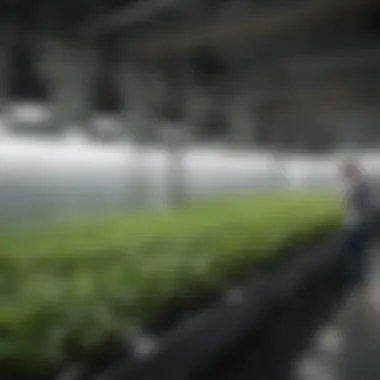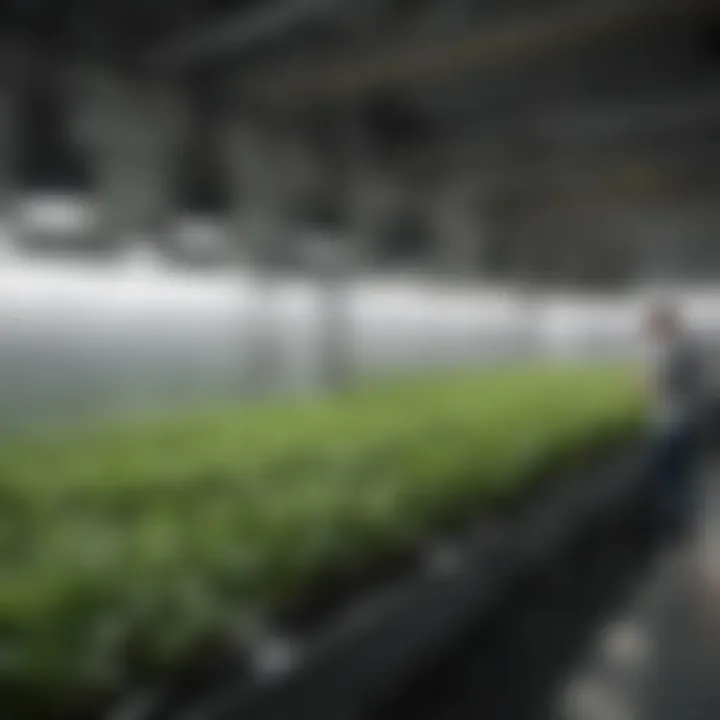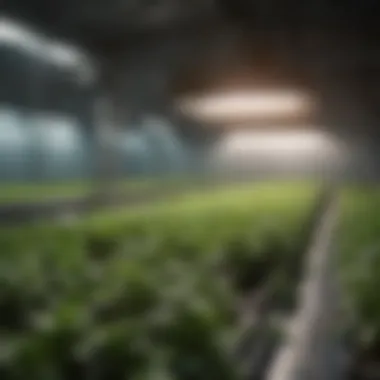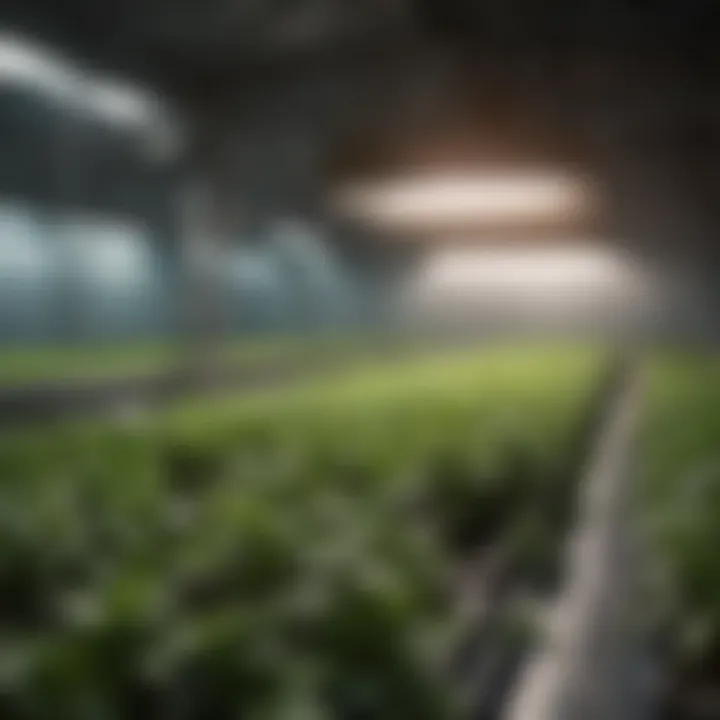Exploring DWC Hydroponic Systems: An In-Depth Analysis


Intro
The realm of agriculture is undergoing significant transformations, particularly with the rising interest in innovative growing techniques. Among these, Deep Water Culture (DWC) stands out due to its effectiveness and simplicity. DWC allows plants to thrive without soil by suspending their roots in nutrient-rich water. This method is an attractive alternative for both small-scale and commercial growers. It provides an avenue for optimizing crop yields while conserving space and resources.
This article aims to explore the intricacies of the DWC system, examining its fundamentals, operational principles, and the advantages it presents over traditional soil-based cultivation. By understanding these aspects, farmers and enthusiasts alike can harness the benefits that DWC offers for sustainable agriculture.
Topic Overview
Definition and Importance
Deep Water Culture is a hydroponic system where plants are grown with their roots submerged in a nutrient solution. The key to DWC is maintaining adequate oxygen levels in the water to support root health. This approach has gained popularity due to several reasons, such as quicker growth rates and reduced risk of pests and diseases common in soil. The ability to tightly control environmental factors enhances not only crop quality but also the overall yield.
Brief History and Evolution
DWC systems are not a recent invention. The principles behind hydroponics date back to ancient civilizations, where various forms of soilless cultivation were practiced. However, the modern iteration of DWC began to emerge in the 1930s when researchers explored methods to optimize plant growth through nutrient solutions. Over the decades, DWC has evolved, integrating technology and innovative practices to become a key player in contemporary agriculture. With the ongoing challenges posed by climate change and urbanization, systems like DWC are increasingly necessary.
Key Techniques and Innovations
Sustainable Farming Practices
Sustainability is at the heart of DWC. By reducing reliance on chemical fertilizers and pesticides, this method aligns with current agricultural trends emphasizing eco-friendliness. Organic nutrient solutions are readily available, making it easier for growers to practice sustainable farming. In addition, DWC systems typically use less water than traditional methods, promoting efficient resource use.
Advanced Agronomic Technologies
Technological advancements have further enhanced the effectiveness of DWC. The integration of sensors for monitoring nutrient levels, pH, and water temperature allows for precision agriculture. Additionally, automated systems can regulate these factors, ensuring optimal growing conditions. Examples include using Arduino or Raspberry Pi for real-time monitoring and adjustments.
Practical Applications
Step-by-Step Guides
Setting up a DWC system involves several straightforward steps. Initially, one must select the appropriate containers and the nutrient solution suited for the specific crop. Next, air pumps and stones are installed to oxygenate the water. It is crucial to ensure that the plants are properly secured and that water levels are maintained throughout the growth cycle. Monitoring plant health and adjusting the nutrient solution as necessary completes the setup.
Case Studies or Real-World Examples
Many farmers and research institutions have successfully implemented DWC strategies. For instance, universities often utilize DWC in their agricultural programs to showcase efficient crop production. Likewise, urban growers are adopting this method on rooftops or in small spaces, proving that DWC can be scalable and accessible to various growing conditions. These examples highlight the versatility and viability of DWC as a mainstream method in modern agriculture.
"The ability to cultivate plants without soil opens up new possibilities for urban farming and sustainable practices."
Whether for small home setups or larger agricultural operations, Deep Water Culture presents a compelling option for those looking to innovate in how they grow crops.
Prelude to DWC Hydroponics
In recent years, hydroponics has emerged as a game-changer in agriculture, allowing for increased efficiency and productivity. Among the various hydroponic systems, Deep Water Culture (DWC) stands out. This introduction aims to outline the significance of DWC hydroponics and its relevance in modern farming.
DWC involves suspending plant roots in a nutrient-rich water solution, providing all the essential elements directly to the plants. This greatly contributes to faster growth rates and resource efficiency, which can address some of the pressing challenges in traditional farming. Additionally, this method enhances overall plant health by reducing the risks of soil-borne diseases, a common issue faced in conventional agriculture.
Understanding DWC hydroponics is crucial for both novice and experienced growers. As interest in sustainable practices increases, knowledge of systems like DWC is key in developing viable agricultural strategies. This section will break down the fundamental aspects of DWC, examining its definition and historical context.
Definition and Overview
Deep Water Culture hydroponics is a method where the roots of the plants are submerged directly in a nutrient solution. The plants are typically held in place using net pots that allow roots to spread into the water. The key feature of DWC is the aeration of the nutrient solution. An air pump, along with air stones, is essential to provide oxygen to the submerged roots. This oxygenation is critical as it supports respiration, prevents root rot, and promotes faster growth.
Advantages of DWC Hydroponics:
- Fast Growth Rates: With nutrient uptake being direct and efficient, plants can grow significantly quicker compared to traditional soil methods.
- Space Efficiency: DWC systems can be vertically stacked, allowing for maximum use of space.
- Reduced Water Usage: Since water is recirculated in this system, it often uses less than traditional methods.
Overall, it is a promising technique combining the benefits of hydroponics with a user-friendly approach that appeals to farmers.
Historical Context
The history of hydroponics dates back to ancient civilizations, where plants were cultivated without soil. However, DWC as a defined method began its rise in the 20th century. The science behind hydroponics developed over decades, gaining attention from researchers seeking alternatives to conventional farming.
In the 1930s, Dr. William Frederick Gericke from the University of California introduced the term "hydroponics." He used solutions of mineral nutrient salts to grow plants in water, laying the groundwork for modern hydroponic practices. DWC began to take shape in the 1960s and 70s when commercial growers started adopting it due to its effectiveness.
As agriculture faced challenges such as soil depletion and changing climate conditions, DWC gained traction. It allowed for producing crops in a controlled environment, leading to increased yields and sustainability. Today, DWC systems continue to innovate and evolve, making them a relevant subject for those involved in agriculture.
Fundamentals of DWC Systems
Understanding the fundamentals of Deep Water Culture (DWC) systems is crucial for anyone interested in maximizing their hydroponic gardening efforts. DWC offers a unique approach to growing plants without soil, relying instead on oxygen-rich water and nutrient solutions. This section focuses on the core principles that underpin DWC systems and outlines the essential components that make it effective. By grasping these basics, growers can make informed decisions that enhance their crop yields and overall gardening experience.
Core Principles
The core principle of DWC systems is simple yet transformative: plants obtain nutrients directly from a water solution, where their roots are submerged. This method allows plants to take up nutrients more efficiently than traditional methods. Oxygen is vital; adding air to the nutrient solution creates a suitable environment for root health and growth. This principle not only accelerates growth rates but also reduces the chances of disease since there is no soil to harbor pathogens.
Basic Components
Each component of a DWC system plays a pivotal role in its overall performance. These basic elements contribute significantly to the optimum growing conditions for plants.


Reservoir
The reservoir serves as the heart of a DWC system. It holds the nutrient solution that supports plant growth. A critical characteristic of the reservoir is its size, which must be sufficient to accommodate the root systems of the plants without frequent water changes. A larger reservoir helps maintain stable nutrient concentrations and temperature, making it a favored choice among growers.
One unique feature of reservoirs is their ability to be made from various materials. While plastic reservoirs are common, the right choice can depend on factors like durability and ease of cleaning. The disadvantage, however, lies in the potential for algae growth if not regularly monitored or maintained.
Air Pump and Air Stones
Air pumps and air stones are essential for providing the necessary oxygen to the nutrient solution. The key characteristic of air pumps is their capacity; a powerful pump can distribute oxygen more evenly, promoting root health. This method is popular due to its effectiveness in preventing over-saturation of the roots while ensuring they receive oxygen; promoting faster growth.
However, a unique feature of air stones is their size and shape. Smaller, porous air stones are able to create more bubbles, which enhances oxygen dispersion. Nevertheless, regular maintenance is required, as clogged stones may hinder the system’s performance.
Net Pots and Media
Net pots are the containers that hold the plants in a DWC system. Their defining characteristic is the mesh structure, which allows roots to extend freely into the nutrient solution. This design is beneficial as it provides excellent drainage while supporting the plant structure effectively.
A unique feature of net pots is their compatibility with different growing media, such as clay pellets or rock wool, which aid in moisture retention. This can be advantageous in ensuring that roots have the right balance of moisture. The disadvantage, however, lies in the potential for media to retain too much water, which can cause root rot without proper monitoring.
"Understanding the components and principles of DWC systems is essential for successful hydroponic gardening."
By focusing on these fundamental aspects of DWC systems, growers can better appreciate how each element contributes to the health and vigor of their plants. Successful implementation of these basics creates a more effective and efficient hydroponic environment.
Advantages of the DWC Method
The Deep Water Culture (DWC) hydroponic method possesses several distinct advantages that make it increasingly popular among growers. Understanding these benefits can help both beginners and experienced farmers optimize their crop production. Throughout this section, we will explore faster growth rates, resource efficiency, and a reduction in disease risks associated with DWC systems.
Faster Growth Rates
One of the most prominent advantages of DWC is the accelerated growth rates observed in plants. This stems from the constant availability of oxygen and nutrients in the water, which roots access directly. In DWC systems, plants are suspended in nutrient-rich water, allowing for unrestricted root development. Studies show that plants such as lettuce and basil grown in DWC can reach harvest size in about 30% less time compared to soil-grown counterparts. This rapid growth can significantly reduce time to market, leading to increased turnover for commercial growers.
Resource Efficiency
Resource efficiency is another critical advantage of the DWC method. Compared to traditional soil growing, DWC systems use far less water. They recirculate nutrient solutions, minimizing wastage. For instance, only about 10% of the water used in a conventional farming system is needed in DWC setups. This feature is particularly vital in regions facing water scarcity. Furthermore, DWC allows for precise management of nutrient levels, reducing overall fertilizer requirements while ensuring that plants receive everything they need for optimal growth.
Reduced Disease Risks
DWC systems also contribute to reduced disease risks in plants. Growing in a controlled environment makes it easier to monitor and manage conditions that would otherwise encourage diseases, like root rot or fungal infections. The elevation of roots in a nutrient solution rather than in soil minimizes direct contact with pathogens. Consequently, the likelihood of pests and diseases plaguing the crops is significantly lower. This proactive approach to plant health leads to higher yields and less need for chemical interventions, promoting a more sustainable growing practice.
"DWC hydroponics combines advanced techniques with simple principles, creating an efficient system that maximizes yield while minimizing resources."
The advantages of the DWC method are compelling and illustrate the efficiency of this hydroponic technique. By leveraging faster growth rates, resource efficiency, and lower disease risks, growers can enhance productivity and sustainability in their agricultural practices.
Setting Up a DWC System
Setting up a Deep Water Culture (DWC) system is essential for maximizing the potential of hydroponic gardening. A properly implemented DWC system ensures plants receive the nutrients they need while providing an environment conducive to growth. Understanding the steps involved in setting this system up can greatly influence yield and quality of the crops grown. Specific elements like location, necessary equipment, and a systematic process all play crucial roles here.
Selecting the Right Location
Choosing the right location for a DWC system can dictate its success. A site with adequate access to electricity and water is fundamental. Proper air circulation and light exposure are also important. Avoid places with extreme temperatures or drafts, as these can stress plants. A shaded area helps to combat excessive heat, especially in warmer months.
The surface should ideally be level and easy to clean. This prevents algae growth and simplifies maintenance. Furthermore, a location away from direct foot traffic reduces the risk of accidental disturbances. Overall, taking time to select an appropriate site will ease subsequent steps in the setup and help provide a stable environment for your plants.
Required Equipment and Materials
To set up a functional DWC system, several pieces of equipment and materials are necessary. Each element supports the growth of healthy plants in a hydroponic setup.
Nutrient Solution
The nutrient solution in a DWC system is the lifeblood for plant growth. It provides essential elements like nitrogen, phosphorous, potassium, and trace minerals to the plants. This solution needs to be balanced to meet the specific needs of the crops you are growing. The primary characteristic of nutrient solutions is their versatility to accommodate different plant types. This adaptability makes nutrient solutions popular among growers who wish to cultivate various crops.
A unique feature of these solutions is that they are typically water-soluble, allowing quick absorption by plant roots. However, growers must watch for nutrient imbalances, which can lead to deficiencies or toxicities in plants, adversely affecting overall growth.
Temperature Control
Maintaining the correct temperature is vital in a DWC setup. Water temperatures should stay within a range of 18 to 22 degrees Celsius for optimal nutrient uptake. Though temperature control equipment can be an initial investment, it is a wise choice due to the direct impact on plant health and growth rates.
A key characteristic of an effective temperature control system is the use of thermostats or heaters that activate as conditions change. Regulating temperature helps avoid root disease, which thrives in warmer conditions. Nonetheless, from a practical standpoint, both high and low temperatures can pose challenges, requiring constant monitoring.
Lighting
Lighting is another crucial element when setting up a DWC system, especially if you are growing plants indoors. Quality lights help mimic natural sunlight, thus supporting photosynthesis. LED grow lights are a favorable choice due to their energy efficiency and long lifespan.
A unique feature of using such lighting systems is their ability to emit specific light spectra, tailored to promote growth phases. However, ensuring proper distance between lights and plants can be necessary to prevent heat stress. Additional considerations include light schedules, which can vary between plant species.
Step-by-Step Setup Process
Establishing a DWC system may seem complex, but breaking it down into steps simplifies the task. Begin by selecting your location, then gather the required equipment and materials. After this, you will need to assemble the components carefully, ensuring everything fits together optimally.
Next, mix the nutrient solution and fill your reservoir. Set up the air pump and air stones to ensure proper aeration of the water. Finally, introduce your plants to the net pots, monitor their status, and make adjustments as necessary. Each step is important, as neglecting one can adversely affect the system.


With successful setup and ongoing management, growers can look forward to robust plant growth in their DWC systems.
Nutrient Management in DWC
Effective nutrient management is crucial in Deep Water Culture (DWC) systems. In a hydroponic environment, plants rely solely on nutrient solutions for their growth, making proper management even more essential compared to traditional methods. Without adequate nutrient levels, plants may display deficiency symptoms or slow growth rates. Therefore, understanding the dynamics of nutrient management in DWC can greatly influence overall plant health and yield.
Understanding Nutrient Solutions
Nutrient solutions supply essential minerals and elements that plants need for growth. In DWC, a balanced solution typically contains macronutrients such as nitrogen, phosphorus, and potassium, along with micronutrients like iron, magnesium, and calcium. The quality and composition of these nutrient solutions determine the productivity of the system.
To achieve a successful nutrient solution:
- Choose water-soluble fertilizers designed for hydroponics.
- Follow manufacturer instructions to mix the right concentration.
- Regularly update the nutrient solution to prevent depletion of vital elements.
It's important for growers to experiment with different formulations to find what best suits their crops. Observing plant responses can guide adjustments in nutrient choices, ensuring optimal growth.
Monitoring pH and EC Levels
Maintaining proper pH and Electrical Conductivity (EC) levels is key in nutrient management. pH affects nutrient availability; if the pH level is too high or too low, certain nutrients become inaccessible to plants. Generally, a pH between 5.5 and 6.5 is ideal for DWC systems.
EC measures the overall nutrient concentration in the solution. A higher EC indicates more nutrients, while a lower EC shows less. For most crops grown in DWC, an EC level of 1.2 to 2.0 is effective. Regularly testing both pH and EC helps in adjusting nutrient intake and prevents deficiencies.
Adjusting Nutrient Ratios
As plants grow, their nutrient needs change. Adjusting nutrient ratios in the solution can lead to improved growth rates and yields. This can be achieved by modifying the concentrations of different elements based on growth stages. For instance:
- During early stages, a higher nitrogen ratio supports leaf and stem development.
- As flowering begins, favoring potassium and phosphorus promotes bud and fruit formation.
Regularly assess plant health and development to guide these adjustments. Accurate observations of growth phases can lead to timely modifications in nutrient ratios, optimizing growth and production.
Nutrient management is not a one-time task; it is an ongoing process that requires careful attention and adjustments to ensure plant health and productivity.
In summary, nutrient management in DWC is pivotal for achieving high yields. Understanding nutrient solutions, monitoring pH and EC, along with making necessary adjustments to nutrient ratios, empowers growers to make informed decisions. This comprehensive approach not only enhances plant growth but also fosters a sustainable hydroponic system.
Common Crops Grown in DWC
The choice of crops cultivated in Deep Water Culture (DWC) hydroponic systems is pivotal for the success of any hydroponic operation. Each type of crop presents unique needs and benefits, shaping the overall productivity of the system. Understanding the specific requirements of different plants informs growers on how to maximize yield and optimize resource utilization.
Leafy Greens
Leafy greens are among the most commonly grown crops in DWC systems. Varieties such as lettuce, spinach, and kale thrive in this environment. These plants generally have a quick growth cycle, allowing for successive harvests.
- Nutritional Needs: Leafy greens require a balanced nutrient solution to support their rapid growth. They typically need higher nitrogen levels at early growth stages to promote lush foliage.
- Light and Temperature: These crops prefer cooler temperatures and moderate light levels, making them ideal candidates for indoor hydroponic setups.
- Market Demand: With increasing health consciousness, the demand for fresh, organic leafy greens has soared. Growing them in DWC can meet this trend effectively.
Herbs
Herbs such as basil, mint, and cilantro are also popular in DWC systems. They generally have a shorter growth cycle and can be harvested multiple times.
- Variety of Flavors: Herbs add flavor and aroma to dishes, making them essential for culinary uses. Their demand in both fresh and dried forms remains high.
- Growth Factors: They benefit from well-aerated water and prefer a slightly warmer temperature compared to leafy greens. Also, concentrated light can enhance their essential oil production.
- Accessibility: The compact nature of herb plants allows for efficient space use in hydroponic systems. Many herbs can be grown in smaller containers, further optimizing the system.
Fruiting Plants
Growing fruiting plants like tomatoes and peppers in DWC is possible and can be very rewarding. These crops require more space and have longer growth cycles, but they can yield significant returns on investment.
- Nutrient Requirements: Fruiting plants have specific nutrient requirements, particularly in potassium and phosphorous, to support flowering and fruit development.
- Support Structures: As these plants grow, they may need support systems to accommodate their weight, which can influence system design.
- Extended Culture Period: The length of growth and care needed poses a challenge but can lead to higher yields if managed correctly.
"Choosing the right crops in DWC is crucial. Each type brings its own set of challenges and advantages that can help maximize the efficiency of the system."
In summary, selecting crops for DWC systems should consider growth rate, nutrient needs, and market demand. Leafy greens and herbs are excellent for new growers, while fruiting plants provide challenges that can yield high rewards when managed effectively. Understanding these factors lays the foundation for a productive hydroponic garden.
Challenges of DWC Hydroponics
Understanding the challenges associated with Deep Water Culture (DWC) hydroponics is crucial for anyone considering this method for crop production. While DWC systems offer a promising framework for enhanced growth and efficiency, they also bring their own set of difficulties that could impact the overall success of cultivation.
Potential System Failures
System failures can occur in a DWC setup due to various reasons. One of the primary concerns is the failure of the air pump. If the air supply is insufficient, the roots may not receive adequate oxygen, which leads to root rot and can ultimately kill the plants. Frequent monitoring of air pump performance is essential.
Aside from the air supply, power outages can disrupt the system's operations. Without power, the water temperature may rise and oxygen levels will drop. Using battery backups is recommended to minimize disruption during outages.
Common Causes of System Failures:
- Clogged air stones
- Malfunctioning pumps
- Electrical issues
Addressing these potential failures requires diligence. Regular checks on equipment will help ensure everything functions correctly.
Pest Management Issues
Pests can thrive even in a hydroponic environment. Some pests, such as aphids and spider mites, are particularly problematic. The absence of soil can initially seem to reduce pest numbers, but aphids can quickly multiply on nutrient-rich water solutions, posing a significant threat to crops grown in DWC systems.


It is necessary to implement an integrated pest management strategy that considers both organic and conventional methods. Biological control agents, such as ladybugs, can help manage aphid populations. Regular inspections will also allow for early detection and swift action.
Prevention Tips:
- Inspect plants for early signs of infestation.
- Use sticky traps to monitor pest activity.
- Maintain a clean growing environment to reduce pest habitats.
Environmental Considerations
Environmental conditions play a significant role in the success of a DWC system. Factors such as temperature, humidity, and light availability are critical for healthy plant growth. Sudden temperature changes can lead to plant stress and reduced yield.
Humidity levels should be balanced. Excess humidity not only encourages mold growth but also creates unfavorable conditions for root respiration. Conversely, low humidity can dry out the plants or stress them.
Effective climate control strategies are essential. Invest in thermostats or humidity sensors to monitor conditions and make adjustments as necessary.
Key Environmental Factors:
- Temperature: Ideally between 65°F to 75°F.
- Humidity: Target around 50%-70%.
- Light Levels: Ensure sufficient light according to plant requirements.
Managing these environmental elements is vital to the overall health and productivity of DWC systems. By addressing these challenges, growers can optimize their hydroponic operations.
Maintenance of DWC Systems
Maintaining a Deep Water Culture (DWC) system is critical for ensuring that plants thrive in this hydroponic environment. The success of cultivation in DWC heavily relies on consistent maintenance, which in turn minimizes potential issues such as nutrient imbalances or system failures. This section will delve into the significance of regular checks and cleanings to uphold the efficiency of the DWC setup.
Routine Checks and Adjustments
Routine checks involve monitoring various critical parameters in the DWC system. Regular evaluation of water levels, nutrient concentration, and pH is essential. Skipping these checks can lead to unexpected plant stress and hinder growth.
- Water Level: Ensure the water level in the reservoir is maintained. Plants rely on sufficient nutrient solution to absorb essential elements.
- Nutrient Concentration: Utilizing tools like a TDS (Total Dissolved Solids) meter helps in assessing nutrient strength. Adjustments may be necessary based on plant growth stages.
- pH Levels: The recommended pH for most hydroponic crops is between 5.5 and 6.5. Regularly test and adjust the pH level to secure optimal nutrient uptake.
- Temperature: Maintaining appropriate water temperature is vital. Water that is too warm can lead to oxygen depletion, while cold water can stress the plants.
In summary, a regular schedule for these routine checks creates an optimal environment. These small adjustments can lead to improved yields and overall health of plants.
Cleaning Protocols
Cleaning protocols are crucial for preventing the buildup of pathogens and algae, which can harm plant health. A transparent plan for cleaning should be established, focusing on key components of the DWC system.
- Reservoir Cleaning: Clean the reservoir every two to three months. Use a mild bleach solution, but make sure to rinse thoroughly to avoid chemical residue.
- Air Stones and Pumps: These components can gather residues over time. Regularly clean or replace air stones and check the pump for any clogs.
- Net Pots: Inspect and clean net pots to eliminate debris which might hinder root growth.
"Clean systems not only enhance plant health but also prolong the life of the equipment used in hydroponics."
Each of these cleaning tasks contributes significantly to the longevity and performance of a DWC setup.
Technological Innovations in DWC
The integration of technological innovations in Deep Water Culture (DWC) hydroponics marks a significant advance in modern agriculture. These technologies enhance both the efficiency and effectiveness of hydroponic systems. As farmers and enthusiasts embrace these advancements, they can achieve better crop yields and optimize resource usage. Alongside traditional practices, these innovations redefine how growers interact with their environment and manage plant health.
Automation and Monitoring
Automation plays a crucial role in modern DWC practices. By incorporating automated systems, growers can manage their hydroponic systems with minimal intervention. Automation of tasks such as nutrient delivery, pH balancing, and water levels ensures a stable environment for the plants. The primary benefits include:
- Consistent Nutrient Supply: Automated nutrient dosing systems ensure precise nutrient levels, which is vital for crop health.
- Data Collection: Automation allows for continuous monitoring of key variables such as temperature, humidity, and light levels.
- Reduced Labor: By automating routine tasks, labor costs and human error are significantly minimized.
Monitoring equipment, including sensors for pH, electrical conductivity (EC), and temperature, provides real-time data. This data can help in making informed decisions about nutrient adjustments and environmental control. The use of mobile apps for remote monitoring is becoming increasingly popular. This enables growers to track system performance even when they are not physically present.
"Technology paves the way for smarter agricultural practices, improving both yield and sustainability."
Integrating IoT in Hydroponics
The Internet of Things (IoT) is revolutionizing hydroponic farming. By connecting various components of a DWC system to the internet, growers gain access to data analytics and machine learning capabilities. This integration transforms how systems operate and improve overall management. Some important considerations include:
- Connectivity: IoT devices allow for seamless communication between sensors and control systems, facilitating quick responses to environmental changes.
- Smart Alerts: Integrated alerts notify growers of any abnormalities, enabling prompt actions to mitigate potential issues.
- Reduced Waste: Intelligent tracking of nutrient usage and water consumption helps in minimizing waste and maximizing resource efficiency.
Implementing IoT solutions in DWC provides a competitive edge. Growers can optimize conditions based on real-time data analysis. Advanced analytics can also assist in predicting crop yield and growth patterns, further enhancing productivity in hydroponic systems. With the ongoing development in this field, the future of agricultural practices, particularly in hydroponics, looks promising.
Epilogue: The Future of DWC Hydroponics
The Deep Water Culture (DWC) hydroponic system stands at a crucial juncture in modern agriculture. It offers solutions to several key challenges faced by traditional farming methods. As we look to the future, understanding the growth potential and sustainability aspects of DWC is essential for farmers and agricultural enthusiasts alike.
Growth Potential
The DWC method has shown remarkable potential for growth in various agricultural sectors. This system allows for faster crop growth, improved yields, and efficient resource utilization. Recent analyses suggest that crops grown in DWC systems can yield significantly more than those in soil-based settings. This advantage is achieved through the constant presence of nutrient-rich water, promoting optimal plant health.
Investments in research have intensified. This has led to advancements in nutrient formulations and system designs that improve efficiency. Furthermore, the ability to grow crops year-round attracts attention from both urban and rural farmers, responding to the increasing demand for fresh produce. The scalability of DWC systems makes it an attractive option for both large-scale operations and small individual growers.
Recent studies on hydroponic technologies have also emphasized the need to adapt to changing climate conditions. DWC's flexibility in indoor and controlled environments allows for consistent production, regardless of external weather influences. This aspect will contribute to food security in various regions, particularly where arable land is limited.
Sustainability Perspectives
Sustainability remains at the heart of contemporary agricultural practices. DWC hydroponics significantly reduces the use of pesticides and herbicides, thus minimizing environmental pollution. The closed-loop system inherently promotes water conservation, as it uses up to 90% less water than traditional farming practices. This is essential in a world increasingly challenged by water scarcity.
Moreover, DWC systems can be implemented in urban settings, utilizing vertical space while reducing the carbon footprint associated with transporting food. This localized production is a key factor in sustainable development. Farmers can adjust their operations in response to market needs without the extended timelines typically associated with conventional soil farming.
To truly embrace the sustainability of DWC, it is essential for growers to integrate eco-friendly practices. Utilizing organic nutrient solutions and exploring renewable energy sources to power systems can further enhance sustainability.
"DWC hydroponics represents a shift toward more efficient and eco-friendly agricultural practices, meeting the demands of a growing population while preserving our natural resources."



